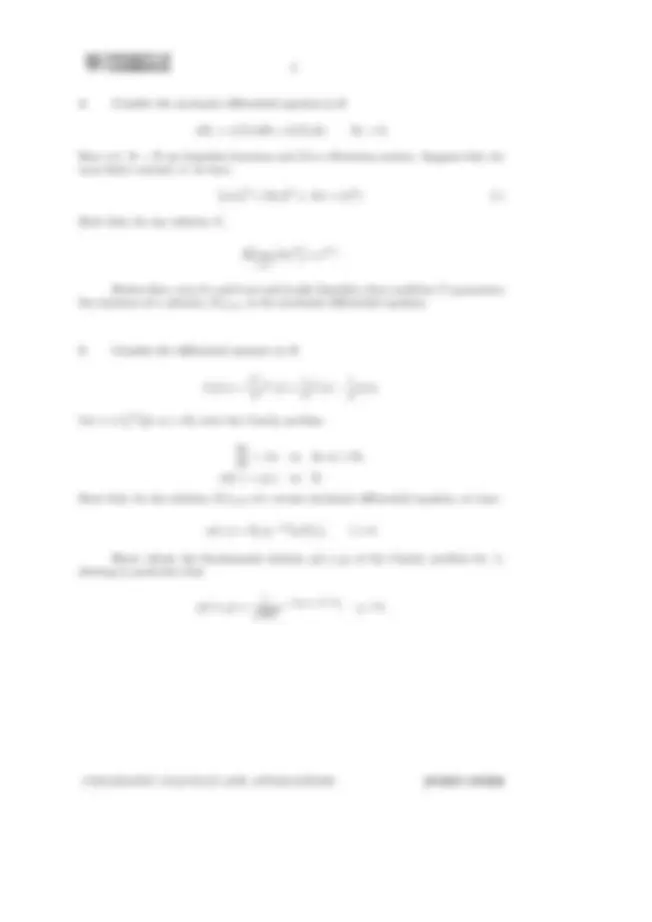




Study with the several resources on Docsity

Earn points by helping other students or get them with a premium plan


Prepare for your exams
Study with the several resources on Docsity

Earn points to download
Earn points by helping other students or get them with a premium plan
Community
Ask the community for help and clear up your study doubts
Discover the best universities in your country according to Docsity users
Free resources
Download our free guides on studying techniques, anxiety management strategies, and thesis advice from Docsity tutors
This is the Exam of Statistical Science which includes Stochastic Differential Equation, Brownian Motion, Solution, Measurable Function, Markov Process, Starting, Bounded Functions, Local Martingale, First Time etc. Key important points are: Stochastic Calculus and Applications One, Continuous Adapted Processes, Finite Variation, Continuous Derivatives, Standard Theorems, Continuous Local Martingale, Brownian Motion, Local Martingale, Quadratic Variation Process, Localization Argument
Typology: Exams
1 / 4

This page cannot be seen from the preview
Don't miss anything!



Tuesday 5 June 2001 1.30 to 4.
Answer FOUR questions. The questions carry equal weight.
1 Let (Ω, F) be a measurable space equipped with a filtration (Ft)t> 0. Explain what is meant by the previsible σ-algebra P.
Consider the case where Ω = (0, ∞) and F is the Borel σ-algebra on Ω. Suppose that (Ft)t> 0 is the natural filtration of the process
Xt(ω) = 1t 6 ω.
Show that
(a) Ft = {B ∈ F : B ⊆ (0, t) or Bc^ ⊆ (0, t)}, (b) P = {((Ω × T ) ∩ {(ω, t) : ω > t}) ∪ (A ∩ {(ω, t) : ω < t}) : A ∈ F ⊗ F, T ∈ F}.
2 Let M be a continuous L^2 -bounded martingale and let H be a strictly simple process, that is, for some 0 = t 0 6 t 1 6... 6 tn and bounded Ftk -measurable random variables Ztk ,
Ht =
n∑− 1
k=
Ztk 1 tk <t 6 tk+.
Define the integral (H · M )t and show that
0
H s^2 d[M ]s
where [M ] is the quadratic variation process of M.
Outline briefly how this identity allows extension of the notion of the integral H ·M to all locally bounded previsible processes.
(^3) Let M be a continuous local martingale starting from 0.
(a) Show that, if f is a C^2 function and f (M ) is of finite variation, then f (M ) ≡ f (0). (b) Show that, if A is a deterministic continuous finite variation process and M 2 − A is a local martingale, then Mt ∼ N (0, At) for all t > 0.
6 In the playground of a large school there is a craze for paper-scissors-stone. This is a game for two players, each of whom simultaneously declares himself or herself to be one of paper, scissors or stone. The winner is decided as follows: scissors cut paper, stone blunts scissors and paper wraps up stone. The loser of any game switches to his opponent’s choice next time, whilst the winner sticks with the same choice.
Suppose that games take place as a Poisson process of rate λ, and that, in each game, the pair of players is chosen randomly from the N children in the playground. Write down a Markov chain model for the proportions of children choosing paper, scissors and stone.
Show that, if λ is taken to be a suitable function of N , then, in the limit as N → ∞, the Markov chain is well approximated (in a sense you should make precise) by the system of differential equations
x˙^1 t = x^1 t (x^3 t − x^2 t ), x ˙^2 t = x^2 t (x^1 t − x^3 t ), x ˙^3 t = x^3 t (x^2 t − x^1 t ).
[Any appeal that you make to standard results should be supported by a precise statement, but not a proof.]
Show that x^1 t x^2 t x^3 t is a constant and comment on this fact in the light of the long time behaviour of the approximating Markov chains.